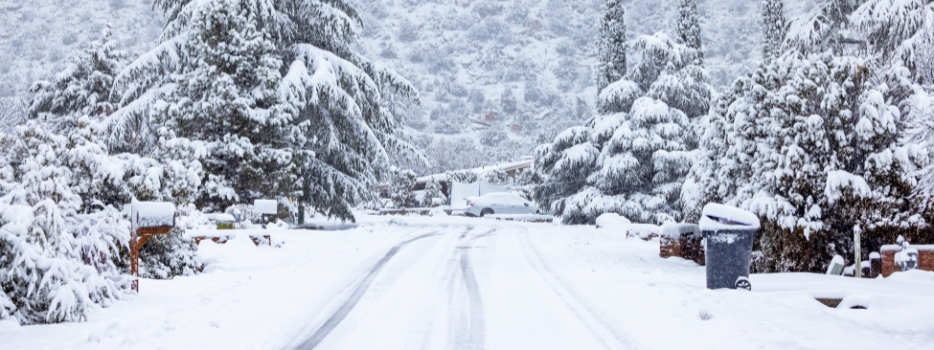Winter is here, and in many areas of the country, that undoubtedly means snow. While it can create a magical winter wonderland, snow can also make sidewalks and driveways hazardous. Whether you're clearing snow yourself or hiring a professional, keeping your property safe is essential. This guide covers removing snow safely, understanding liability, and selecting professional services when needed.
Who’s responsible for snow removal?
Whether you’re a homeowner, landlord, or renter, clearing snow is often unavoidable in snowy regions. As a homeowner, it’s your responsibility to ensure walkways and driveways are safe. Not removing snow can lead to injuries, fines, or even lawsuits.
If your city has a snow removal ordinance, be sure you understand and follow it. Many ordinances require walkways to be cleared within 24 to 48 hours. Failing to comply could result in fines.
For renters and landlords, responsibilities can vary. If you’re renting a single-family home, you may be responsible for shoveling snow. In multi-family properties with shared walkways, landlords or management companies usually handle the task. Clarifying this in a lease agreement benefits all parties involved.
Snow removal safety tips
Shoveling snow may seem like a routine chore, but it’s one that requires preparation and care. Heavy snow can lead to significant exertion, as well as bending and twisting in ways your body isn’t used to—especially if you live a sedentary lifestyle. Here’s how to stay safe:
-
Warm up appropriately. Cold weather makes muscles, ligaments, and tendons tighten. Gentle stretching or light exercises before shoveling can prevent injuries.
-
Don’t jump out of bed. Some storms dump snow overnight, leading to a rough morning. Avoid shoveling immediately after waking, as heart attacks often occur in the morning. Wait at least 30 minutes.
-
Don’t shovel after dinner. Shoveling snow on a full stomach diverts blood from your heart needed to aid digestion. Vigorous activity too soon can strain your body.
-
Avoid drinking alcohol. Alcohol can affect your balance and judgment while giving you the sensation of being warm.
-
Take frequent breaks. Shoveling is an aerobic exercise. If you’re winded, take a break and drink water.
-
Lift small amounts of snow. Don’t try to lift more snow than you can handle. Lifting heavy snow can raise your blood pressure and increases the risk of injuries.
-
Use a snowblower if you have one. Shoveling may seem like a good workout, but tools like snowblowers can reduce strain on your body.
-
Have a plan. With today’s forecasting technology, you can prepare for storms. Depending on the snowfall, you might need to shovel multiple times. Pace yourself because rushing can lead to injury.
-
Use proper technique. Push snow instead of lifting when possible. When lifting, use your legs and avoid quick or aggressive movements that can strain your arms or shoulders.
-
Take your smartphone. Have your smart phone with you in case of emergencies.
-
Know when to get medical attention. If you experience any warning signs of heart attack or concussion, seek medical attention immediately. Monitor muscle pain, especially in the back and shoulders, and if significant, have it checked out.
Avoiding liability: Do you have the right insurance coverage?
Snow and ice pose risks not only to you, but to others. If someone slips and falls on your property, you could face an insurance claim—or even a lawsuit. Clearing snow promptly and salting or sanding freshly-cleared areas can help prevent accidents. Keeping paths to mailboxes and garbage bins accessible is also crucial to avoid issues for delivery drivers and sanitation workers. To protect yourself further:
-
Check your homeowners policy. Liability and Medical Payments coverages typically respond if you’re found liable for an injury. However, if your coverage is limited to $100,000, it may not be enough to cover medical expenses. Rising healthcare costs make it essential to review your policy with your insurance agent.
-
Consider Umbrella Liability insurance. If your liability coverage is exhausted, an umbrella policy can provide at least $1,000,000 in additional coverage.
When to hire professional help
If shoveling snow feels like too much of a chore or you’ve been injured doing it, consider hiring a professional snow removal service. Following these tips will help ensure a smooth business relationship:
-
Do some research. Ask friends, family, or coworkers for referrals. They can share insight on costs, reliability, and workmanship.
-
Shop around. Get multiple estimates in writing. Not only does this allow you to compare prices, how a company presents an estimate can reveal a lot about their professionalism.
-
Check reviews. Use the Better Business Bureau (BBB) and other online platforms to see ratings and reviews.
-
Understand the services provided. Before signing a contract, ask questions like:
- When will my property be cleared?
- Do you prioritize businesses over residential customers?
- Will you salt after a wintry mix?
- Is the fee a flat rate, or does it depend on snow accumulation or day of snowfall (i.e., premium rates on weekends)?
-
Get a written contract. Verbal agreements can lead to disputes. A written contract should clearly detail all terms, including termination policies.
-
Confirm insurance coverage. Ensure the contractor has Liability and Workers’ Compensation insurance to protect you in case of accidents.
-
Inspect their equipment. Contractors should have well-maintained equipment. While a dented truck is acceptable, a poorly kept one may indicate an unreliable service.
Snow removal may not be the most enjoyable part of winter, but it’s necessary to keep your property safe. By following safety tips, understanding your responsibilities, and using professional services when needed, you can enjoy the beauty of winter without the risks. Review your insurance policy, invest in proper tools, or leave the heavy lifting to the pros—it’s all about finding the best solution for your needs.






